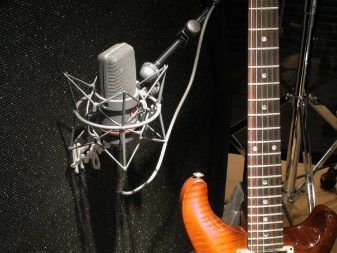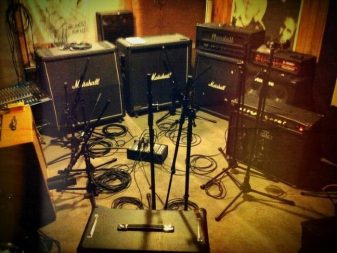 After having explored recording the acoustic guitar, it’s time to discuss various techniques and options we can use to capture the glorious sound of electrics. Nowadays, we have so many different options for recording this beloved instrument; it’s hard to imagine a better time to be a guitarist. In the past, you had to utilize multiple pieces of outboard gear in addition to a guitar and amplifier. This method is still valid today, but thankfully it’s possible to achieve great results with a much smaller (and quieter) operation. I’ll explain these techniques in detail. If you are completely new to recording though, please refer to my introduction here.
After having explored recording the acoustic guitar, it’s time to discuss various techniques and options we can use to capture the glorious sound of electrics. Nowadays, we have so many different options for recording this beloved instrument; it’s hard to imagine a better time to be a guitarist. In the past, you had to utilize multiple pieces of outboard gear in addition to a guitar and amplifier. This method is still valid today, but thankfully it’s possible to achieve great results with a much smaller (and quieter) operation. I’ll explain these techniques in detail. If you are completely new to recording though, please refer to my introduction here.
Using microphones
For those of you that have the space and the patience to deal with micing up a guitar amp, you are in luck. This is the absolute best way to get an electric guitar tone recorded. All my favourite recordings were made this way, and a lot of modern productions still rely on this procedure. It offers a lot of different possibilities and also gets very loud, so make sure you arm yourself with patience and warn your neighbours and housemates.
 Usually, dynamic microphones are used. Since they handle high sound pressure levels (volume), they are well suited for loud, overdriving amplifiers. The most widespread guitar mic is the Shure SM57, and it’s very affordable. Other classic microphones include the Sennheiser MD421 and e609. Condenser models are sometimes also used, but not necessary. You’ll also commonly hear about the Royer R121, a ribbon model that can handle high levels of volume while delivering a beautifully coloured version of your tone.
Usually, dynamic microphones are used. Since they handle high sound pressure levels (volume), they are well suited for loud, overdriving amplifiers. The most widespread guitar mic is the Shure SM57, and it’s very affordable. Other classic microphones include the Sennheiser MD421 and e609. Condenser models are sometimes also used, but not necessary. You’ll also commonly hear about the Royer R121, a ribbon model that can handle high levels of volume while delivering a beautifully coloured version of your tone.
Various techniques
Mic placement is usually up close, near the speaker grill. You then adjust the position closer or further away from the speaker cone to get the right amount of brightness. The closer you are to the middle, the more highs you will capture. A very popular technique is to pair two microphones and have one capture the high end, while blending in the body of the tone from the other mic. Some more elaborate setups add in a room mic to get an interesting dimension of space. This can be used to good effect if the room in which the amp is placed has pleasant sounding reflections. If you try this, be ready to experiment a lot to find the right position and distance from the amplifier.
Traditionally, sound technicians use either great standalone or console-integrated preamps. These are really nice but can be overkill for a home studio. You can simply rely on a good sounding audio interface such as Focusrite’s Scarlett series. They have very clean preamps that will let you concentrate on the actual microphone placement.
Lastly, don’t forget about the extra accessories you’ll need, such as mic stands and XLR cables to route the signal to your interface. There are small stands available that are very convenient for recording guitar amplifiers.
Direct options
For most people, the easiest, most efficient manner of recording guitar is by plugging directly into an audio interface or effects processor that can interface with your computer. This has greatly revolutionized how guitarists work and create.
Plugins
 A very popular and flexible way of recording the guitar is to use plugins on a direct signal. By using software instruments like IK Multimedia’s Amplitube 5, you’ll have access to convincing amplifier models and all the effects you’ll ever need or want. The most convenient aspect is that you can even modify the tone well after you’re done recording. Since you are actually working on the original dry guitar signal, you can come back days or weeks after you’re done recording to carefully tailor the tone to your liking. As soon as you are done capturing the perfect performance, you can focus entirely on getting the right sound. This has one more advantage: you can bring your DI performances to a studio and record that signal passed through a high-quality guitar amplifier. We call this technique reamping.
A very popular and flexible way of recording the guitar is to use plugins on a direct signal. By using software instruments like IK Multimedia’s Amplitube 5, you’ll have access to convincing amplifier models and all the effects you’ll ever need or want. The most convenient aspect is that you can even modify the tone well after you’re done recording. Since you are actually working on the original dry guitar signal, you can come back days or weeks after you’re done recording to carefully tailor the tone to your liking. As soon as you are done capturing the perfect performance, you can focus entirely on getting the right sound. This has one more advantage: you can bring your DI performances to a studio and record that signal passed through a high-quality guitar amplifier. We call this technique reamping.
There are tons of plugins available now, and you can even mix and match their different parts. For example, you can use the amplifier model of one software instrument, send it through the effects of another, and load an impulse response from the library of another developer for the cabinet simulation. Impulse responses are a highly accurate representation of guitar cabinets in various spaces using high quality microphones.
Effects processors
Some effects processors allow you to use them as an audio interface and record your electric guitar. This is a really handy option for guitarists that plan on eventually performing these recordings to an audience. You can take the exact recorded tones with you on stage without any problems. You can even integrate them in traditional pedalboards for a more authentic experience. Boss’s GT-1000 and GT-1000 Core and Zoom’s G6 are examples of such processors.
Loading down amplifiers
One of my favourite compromises between using a microphone and going direct is by loading down an amplifier and applying a cabinet impulse response on the output. If you have a (or multiple) nice tube amplifiers, but don’t have the space to crank them up for a recording, this is the next best thing. It captures all the character of the preamp and poweramp—two essential parts of guitar tone. You’ll need an appropriate load box, such as Two Notes Torpedo or Boss’s Tube Expander. You’ll then be able to send the signal from the load box to your audio interface and edit it in a DAW. This is another new technique that really gives great results without much hassle.

It’s a very exciting time to be a guitarist. All these various options are fun to explore and offer great results. They have their own advantages and disadvantages, so I encourage you to explore every one of them to see which one works best for you. Like I mentioned in the acoustic guitar article, recording is like an instrument in itself—it takes a lot of practice and experimentation before things become second nature. Try to take your time and make note of how all the parameters you modify affect the tone. I can’t wait to hear what you come up with!
Check out all the recording gear on Best Buy’s website.



